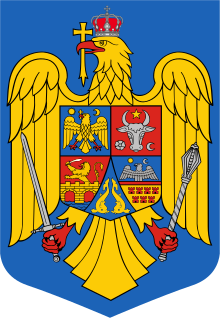Transylvanian School
The Transylvanian School (Romanian: Școala Ardeleană) was a cultural movement which was founded after part of the Romanian Orthodox Church in Habsburg-ruled Transylvania accepted the leadership of the pope and became the Greek-Catholic Church (c. 1700). The links with Rome brought to the Romanian Transylvanians the ideas of the Age of Enlightenment. The Transylvanian School's major centres were in the cities of Blaj, Oradea, Lugoj and Beiuş.
Part of a series on the |
|---|
| History of Romania |
 |
|
Post-Revolution |
|
|
Its members contemplated the origin of Romanians from a scientific point of view, bringing historical and philological arguments in favour of the thesis that the Transylvanian Romanians were the direct descendants of the Roman colonists brought in Dacia after its conquest in early 2nd century AD.
The Transylvanian School had a notable impact in the Romanian culture of both Transylvania, but also of the Romanians living across the Carpathians, in Wallachia and Moldavia, leading to the national awakening of Romania.
Samuil Micu-Klein, Gheorghe Şincai, Petru Maior and Ion Budai-Deleanu, who were members of the Transylvanian School during the era of Romanian national awakening, emphasised the ancient purely[1] Latin origin of Romanians to enhance the political and cultural prestige of Romanians in Western Europe. In 1791, they contributed in the memorandum: "Supplex Libellus Valachorum Transsilvaniae". In this memorandum, they demanded similar rights for the Transylvanian Romanians as those enjoyed by the Hungarian nobles, the enfranchised Saxon bourgeois and Székelys under the Union of the Three Nations.[2] This document was presented to Emperor Leopold II by the Transylvanian School.[3]
The Transylvanian School created the current phonetic system of the Romanian alphabet based on the Latin alphabet, largely derived from the Italian and the French alphabets. This replaced the use of the medieval Romanian Cyrillic alphabet as well as the previously Latin alphabet based phonetic system which had been based on the Hungarian alphabet. Another notable contribution of the Transylvanian School was the usage of the first French and Italian neologisms.
Notable members
- Petru Maior
- Samuil Micu
- Gheorghe Şincai
- Ion Budai-Deleanu
See also
References
- Stuart Macintyre, Editors: Daniel R. Woolf, Andrew Feldherr and Grant Hardy (2011). The Oxford History of Historical Writing, Volume 4, 1800-1945. OUP Oxford. p. 352. ISBN 9780199533091.CS1 maint: multiple names: authors list (link)
- Marcel Cornis-Pope; John Neubauer (2004). History of the Literary Cultures of East-Central Europe: Junctures and Disjunctures in the 19th and 20th Centuries, Volume 2. John Benjamins Publishing. p. 255. ISBN 9789027234537.
- Cristian Romocea (2011). Church and State: Religious Nationalism and State Identification in Post-Communist Romania. Bloomsbury Publishing. p. 112. ISBN 9781441137470.